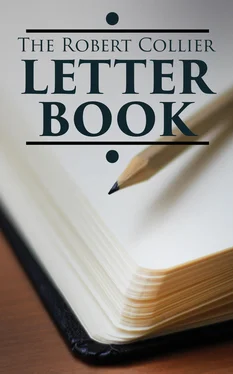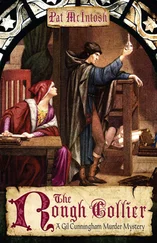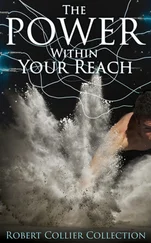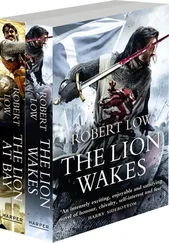Robert Collier
The Robert Collier Letter Book
The Ultimate Guide for Copywriting
e-artnow, 2021
Contact: info@e-artnow.org
EAN: 4064066498870
Preface PREFACE Table of Contents This is not a textbook, calculated to show the beginner how to take his pen or typewriter in hand and indite a masterly epistle to some fancied customer. It is for the business man who already knows the theory of letter writing but is looking for more effective ways of putting it into practice. It covers all the necessary rules, of course, but it does this informally. Primarily, it is the log book of a long and varied experience. It shows successful ways of selling all manner of products, from coal and coke right on down to socks and dresses. But through all the differences in products and appeals, runs this one connecting thread—that while products and reasons for buying may vary, human nature remains much the same; that familiarity with the thing you are selling is an advantage, but the one essential without which success is impossible in selling, by mail or selling in person, is a thorough understanding of human reactions. Study your reader first—your product second. If you understand his reactions, and present those phases of your product that relate to his needs, then you cannot help but write a good letter. It may be said of this book that it does not give enough examples of unsuccessful letters. But most of us can find plenty of these in our own files. And isn’t it true that we are far less concerned with why a letter failed than in finding out what it is that makes a letter successful? The first book on business letter writing I ever read was the "Business Correspondence Library” published by System a good many years ago. To it, and to "Applied Business Correspondence” and other books by Herbert Watson, I owe most of my theoretical knowledge of letter writing. Those familiar with Watson’s writings will recognize many of his theories in the early chapters of this book. I gladly give acknowledgment to him as the one on whose writings the groundwork of my own education in direct mail was laid. To John Blair, President of the New Process Company of Warren, Pennsylvania, I am indebted for numberless opportunities to test my pet ideas in the only crucible that gives dependable results—actual letters sent to prospective buyers—and for the perfect records that enabled me to see which theories were workable, which better forgotten. For many of the short paragraphs used as examples of good starters, graphic descriptions, or proper closers, I am indebted to writers like Ad-Man Davison and Ben Sweetland and to such magazines as Printers' Ink and System. To all of these I give acknowledgment and express sincere appreciation. THE AUTHOR NEW YORK, N. Y. May, 1931.
Chapter 1. What is it that Makes Some Letters Pay?
Chapter 2. How to Arouse that Acquisitive Feeling
Chapter 3. Getting News Interest Into Your Letter
Chapter 4. Word Pictures that Make People Want Your Product
Chapter 5. Motives that Make People Buy
Chapter 6. The Proof of the Pudding
Chapter 7. Supplying that Impulse
Chapter 8. How to Put a Hook Into Your Letters
Chapter 9. The Six Essentials
Chapter 10. How It All Began
Chapter 11. The First Olive
Chapter 12. Selling $2,000,000 Worth of O. Henry Stories
Chapter 13. A War History that Sold
Chapter 14. Books that Many People Know
Chapter 15. How Wells’ "Outline" was Sold
Chapter 16. How the Bookbuyers Saved a Campaign
Chapter 17. A Giant of the Mails
Chapter 18. The Third Fifty Thousand
Chapter 19. Will You Accept This Little Gift?
Chapter 20. One Million Dollars’ Worth of Orders in the First Six Months
Chapter 21. How Closely Can You Follow Up Leads?
Chapter 22. We Help to Start a Store
Chapter 23. How to Reach the Leaders
Chapter 24. Collecting with a Smile
Chapter 25. The Ideal Sales Letter
Chapter 26. How to Raise Money by Mail
Table of Contents
This is not a textbook, calculated to show the beginner how to take his pen or typewriter in hand and indite a masterly epistle to some fancied customer.
It is for the business man who already knows the theory of letter writing but is looking for more effective ways of putting it into practice.
It covers all the necessary rules, of course, but it does this informally. Primarily, it is the log book of a long and varied experience.
It shows successful ways of selling all manner of products, from coal and coke right on down to socks and dresses. But through all the differences in products and appeals, runs this one connecting thread—that while products and reasons for buying may vary, human nature remains much the same; that familiarity with the thing you are selling is an advantage, but the one essential without which success is impossible in selling, by mail or selling in person, is a thorough understanding of human reactions.
Study your reader first—your product second. If you understand his reactions, and present those phases of your product that relate to his needs, then you cannot help but write a good letter.
It may be said of this book that it does not give enough examples of unsuccessful letters. But most of us can find plenty of these in our own files. And isn’t it true that we are far less concerned with why a letter failed than in finding out what it is that makes a letter successful?
The first book on business letter writing I ever read was the "Business Correspondence Library” published by System a good many years ago. To it, and to "Applied Business Correspondence” and other books by Herbert Watson, I owe most of my theoretical knowledge of letter writing. Those familiar with Watson’s writings will recognize many of his theories in the early chapters of this book. I gladly give acknowledgment to him as the one on whose writings the groundwork of my own education in direct mail was laid.
To John Blair, President of the New Process Company of Warren, Pennsylvania, I am indebted for numberless opportunities to test my pet ideas in the only crucible that gives dependable results—actual letters sent to prospective buyers—and for the perfect records that enabled me to see which theories were workable, which better forgotten.
For many of the short paragraphs used as examples of good starters, graphic descriptions, or proper closers, I am indebted to writers like Ad-Man Davison and Ben Sweetland and to such magazines as Printers' Ink and System.
To all of these I give acknowledgment and express sincere appreciation.
THE AUTHOR
NEW YORK, N. Y. May, 1931.
CHAPTER 1
WHAT IS IT THAT MAKES SOME LETTERS PAY?
Table of Contents
What is there about some letters that makes them so much more effective than others?
A letter may have perfect diction, a finished style; it may bristle with attention-getters and interest-arousers; it may follow every known rule; yet when it reaches the Hall of Judgment where the reader sits and decides its fate, it may find itself cast into the hell of wastebasketdom, while some screed lacking any pretense of polish or the finer arts of correspondence, blandly picks up the bacon and walks home with it. Why?
Because getting the results you set out to accomplish with a letter is no more a matter of rule of thumb than is landing a fish with a rod and hook. You know how often you have seen some ragged urchin pull in fish after fish with the crudest of lines, when a "sportsman” near by, though armed with every piscatorial lure known to man, could not raise even a bite!
It’s a matter of bait, that’s all. The youngster knew what the fish would bite on, and he gave it to them. Result? A mess of fine fish for dinner. The "sportsman” offered them what he had been led to believe fish ought to have—and they turned up their fishy noses at it.
Читать дальше











